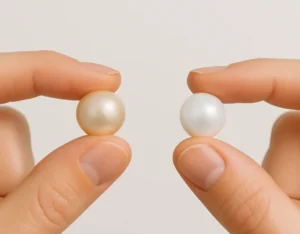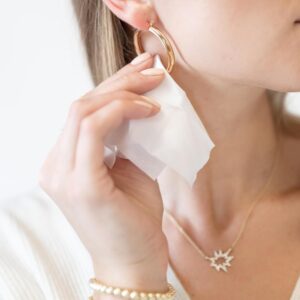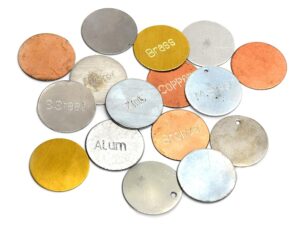Jewelry isn’t just about sparkle. It holds memories, milestones, and meaning. Whether it’s a $30 necklace or a family heirloom, taking care of it keeps the beauty—and the story—alive.
Why it matters:
- Preserves shine and brilliance
- Prevents damage or tarnish
- Keeps it hygienic (yes, your rings touch a lot!)
Caring for your jewelry also helps with sustainability (less replacing) and saves money long-term.
Table of Contents
Jewelry Care Tips
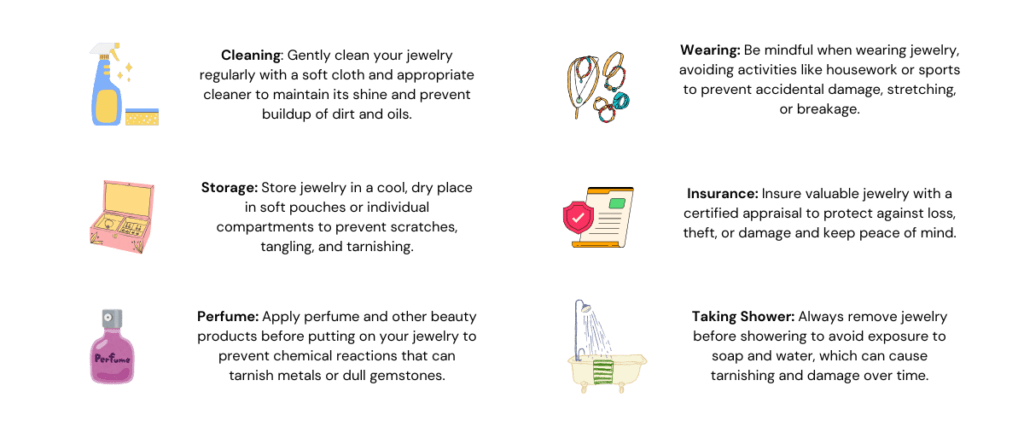
Understand Your Jewelry: What Needs What?
Let’s be honest—not all jewelry is created equal. What works for one piece can totally ruin another. That’s why understanding what type of jewelry you have is the first step to keeping it beautiful for years.
Start with the Basics: Fine, Costume, or Plated?
Think of your jewelry like clothes. You wouldn’t wash silk and jeans the same way, right? Jewelry is the same—different types need different care.
- Fine Jewelry: This is made from real gold, silver, or platinum, and often has real gems like diamonds, emeralds, or sapphires. These pieces are strong but can still get damaged—especially the stones—so handle them with care.
- Costume Jewelry: Fun and trendy, but made from cheaper metals like brass or nickel. These pieces are not made to last forever. Keep them away from water, perfume, and sweat—they can fade or turn green fast!
- Plated Jewelry: These look like gold or silver, but they’re just coated with a thin layer. The inside is a different metal. If you wear them every day or clean them too hard, the top layer can rub off quickly.
Some jewelry needs extra care:
- Pearls are soft and can be easily damaged. They don’t like chemicals—so keep them away from perfume, hairspray, and makeup.
- Opals are delicate and don’t like to dry out or get too cold. They can crack if the temperature changes too much.
- Antique Jewelry is old and may have weak parts. If you clean it too hard, it might break.
Expert Tip: Always check the tag or ask the seller what kind of jewelry it is. That way, you’ll know how to take care of it from the start.
Use This Jewelry Care Chart
Here’s a simple cheat sheet to help you care for different materials:
| Material / Gem | Use This Cleaner | Avoid This | Clean How Often |
|---|---|---|---|
| Gold | Mild dish soap + water | Harsh chemicals, toothpaste | Monthly |
| Silver | Polishing cloth | Bleach, water dips | When tarnished |
| Pearls | Damp soft cloth | Soaking, sprays, cleaners | After every wear |
| Diamonds | Warm water + soft brush | Chlorine, bleach | Monthly |
| Opals | Damp cloth | Heat, dryness, alcohol | Every few wears |
| Costume | Dry soft cloth | Water, perfume | Weekly |
| Plated | Mild soap, gentle hands | Scrubbing, rubbing hard | Every few wears |
| Antique Jewelry | Soft dry or slightly damp cloth | Hard brushing, strong cleaners | Occasionally, and very gently |
Daily Jewelry Care Routine
Jewelry doesn’t just stay shiny on its own—it needs a little daily love. The good news? A few easy habits can keep your favorite pieces glowing and lasting longer.
Here’s your daily jewelry care checklist—no stress, no fancy tools, just smart steps!
Quick Care Tips You Can Do Every Day
- Wipe It After Every Wear: Gently wipe your jewelry with a soft microfiber cloth before putting it away. It removes oils, sweat, and dust that build up during the day.
- Keep Lotions, Perfume & Sprays Away: These products may smell great, but they can dull metals and damage gemstones—especially pearls and plated jewelry.
- Avoid Wearing Jewelry in Pools or Showers: Chlorine, saltwater, and even shampoo can eat away at the finish of your jewelry. Always remove your jewelry before swimming or showering.
- Put Jewelry On Last, Take It Off First: Always wear your jewelry after you’re done with makeup, lotion, or perfume. This keeps it safe from damage. And when you’re getting undressed, take your jewelry off first to avoid breaking or snagging it.
- Rotate Your Jewelry
Don’t wear the same piece every day. Give your jewelry a break to prevent wear and tear. Try making a weekly plan to switch up your rings, earrings, and necklaces. Wear Silver Often: Silver jewelry can turn dark or dull (this is called tarnishing) when it’s not used for a long time. But when you wear it, the natural oils from your skin help keep it shiny and clean. So instead of leaving your silver jewelry in a box, wear it often to keep it looking nice!
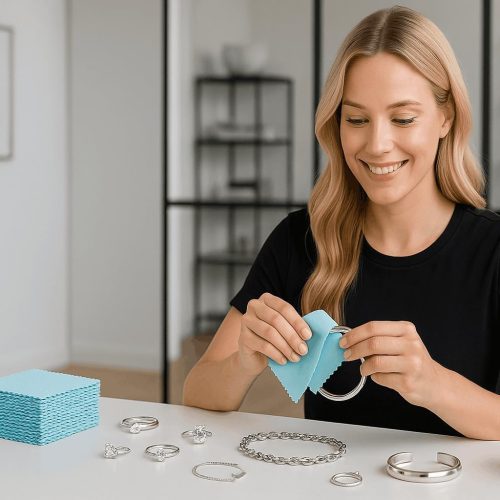
How to Clean Jewelry at Home Safely
Cleaning your jewelry at home doesn’t need to be scary or complicated. You just need to know what works—and what to absolutely avoid. Let’s go step by step through jewelry cleaning tips based on the type of jewelry you own.
Gold and Diamond Jewelry cleaning
These pieces are some of the toughest—but they still need gentle cleaning to stay sparkly.
How to Clean:
- Mix a few drops of mild dish soap in a bowl of warm (not hot) water
- Soak your gold or diamond jewelry for 10–15 minutes
- Use a soft toothbrush to gently scrub any crevices
- Rinse under clean water and dry with a soft cloth
Quick Tip: Don’t use paper towels—they can scratch the metal or stone surface.
Sterling Silver Jewelry cleaning
Silver is beautiful but it can tarnish easily. Luckily, cleaning it at home is super easy.
How to Clean:
- Use a silver polishing cloth to gently rub off tarnish
- Or make a paste with baking soda + a little water, then rub gently and rinse
- Dry with a clean, soft cloth
Avoid:
- Harsh chemical dips
- Toothpaste (yes, it’s too abrasive!)
Only use silver cleaning liquids if they are high quality and made for real silver. Even then, use them very little and not too often, because they can be too strong.
Pearls, Opals and Other Soft Stones
These delicate gems need extra care—no soaking, no scrubbing, and definitely no harsh cleaners.
How to Clean:
- Dampen a very soft cloth with clean water (not hot or soapy)
- Gently wipe the surface
- Let them air dry flat before storing
Important:
- Never soak pearls or opals
- Don’t use soap, vinegar, or cleaners—even “natural” ones
Cleaning Myths You Should Avoid
Let’s clear up a few common DIY tips that can actually damage your jewelry:
- Toothpaste: Too abrasive for all metals and stones
- Vinegar or lemon juice: Harmful to pearls, opals, and soft stones
- Boiling water: Can crack stones or loosen glue
- Baking soda on pearls: Can scratch their delicate surface
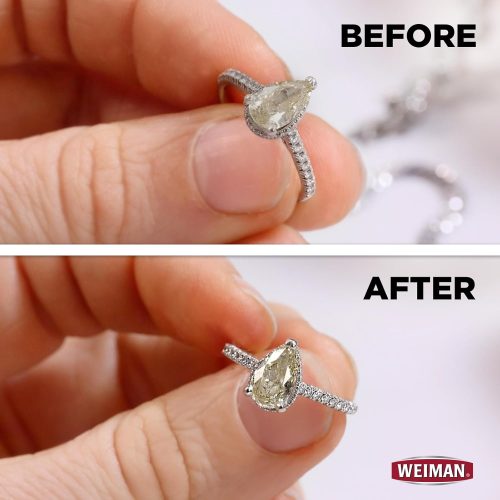
Disinfect Your Jewelry
We don’t often think about it, but our jewelry can carry germs—especially rings and earrings we wear daily or while out in public.
So, yes—sometimes you should disinfect your jewelry. But it has to be done the right way.
When Should You Disinfect Your Jewelry?
Disinfecting isn’t something you need to do daily, but there are times when it’s a smart move:
- After being sick or recovering from an illness
- After traveling, especially on planes or public transport
- When you’ve shared earrings or rings (even with family!)
- If you’ve worn jewelry to a hospital, gym, or crowded event
Safe Ways to Sanitize Jewelry (Without Ruining It)
Not all cleaners are safe for jewelry! Here are the ones you can use without harming it:
- Gentle Soap Soak: Mix mild dish soap in warm water. Soak jewelry for 10–15 minutes. Rinse and pat dry with a clean cloth
(Great for gold, silver, diamonds, stainless steel) - Alcohol Wipes: Use for solid metal surfaces (rings, bracelets, non-porous earrings). Gently wipe—don’t soak!
(Best for disinfecting after travel or sickness)
What You Should Never Use
Some cleaners are too strong and can ruin your jewelry.
- Bleach – It’s strong and can corrode metal
- Strong hand sanitizers – These often contain alcohol and other chemicals that can strip finishes or ruin pearls
- Hydrogen peroxide – It’s too harsh for soft stones and may weaken glue-set gems
- UV sanitizers – Can cause heat and damage delicate stones over time
Jewelry Storage Tips to Avoid Tarnish and Tangles
Let’s be honest—nothing’s more annoying than finding your favorite necklace all tangled up. Or worse… looking old and dull.
The good news? With a few easy storage tips, you can keep your jewelry shiny, neat, and safe from damage.
Store Pieces Separately to Prevent Scratches and Tangles
Jewelry needs personal space—yes, even tiny earrings!
- Use separate pouches or soft boxes to stop pieces from scratching each other
- Add anti-tarnish strips to help keep silver, gold, and plated jewelry shiny
- For thin chains, put one end through a straw and close the clasp to stop tangles
- Keep each pair of earrings together in a small zip bag or press them into soft foam
Use zip-lock bags for silver
It may not look fancy, but it works! Silver hates air—and even more, it hates moisture.
- Use tiny zip-lock bags to seal out air
- Add a silica gel packet (like the ones in new shoes) to absorb moisture
- Press out the air before sealing the bag
Avoid These Jewelry Storage Mistakes
Sometimes the way we store jewelry does more harm than good.
Don’t store jewelry…
- In the bathroom—the steam causes metals to tarnish and stones to loosen
- In direct sunlight—this can fade gemstones and weaken glue settings
- Near lotions or perfumes—residue can transfer onto the jewelry and cause buildup
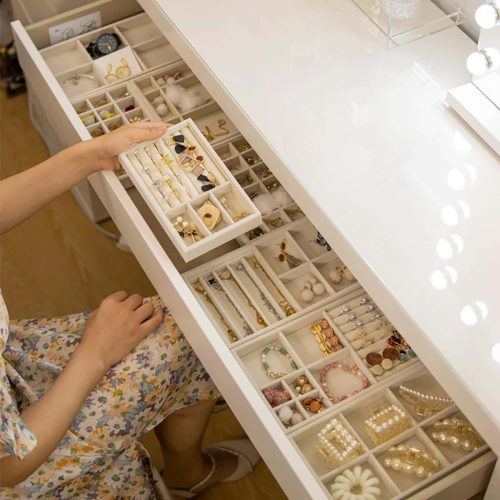
Jewelry Tips for Travel
Keep it safe, shiny, and stress-free!
Traveling with your favorite jewelry? Whether it’s a beach trip, wedding weekend, or business trip—keeping your jewelry safe and untangled on the go is all about smart packing.
Let’s go over the essentials so you can travel confidently and come back with every piece still sparkling.
- Use a travel jewelry case: Pick a small case with separate sections to stop your jewelry from scratching or getting tangled.
- Wrap delicate pieces: For pearls or rings with stones, use a soft cloth or pouch to protect them.
- Necklace trick: Put one end of your chain through a plastic straw and close the clasp. This keeps it from getting knotted.
- Keep earrings together: Stick each pair to a small card or push them through a button so they don’t get lost.
- Don’t check in your jewelry: Always keep valuable pieces in your carry-on bag, not in your checked suitcase.
- Use zip bags for quick storage: Keep a few small zip bags with you in case you need a safe spot to store your jewelry quickly.
- Pack a tiny care kit: Bring a small cloth, a ring cleaning pen, and a little brush to clean your jewelry while traveling.
When to See a Professional
Sometimes your jewelry needs expert help. Here’s how to know it’s time to visit a professional:
- Something feels loose or wobbly? If a stone moves, a clasp feels weak, or a prong looks bent—get it checked right away before it falls off or breaks.
- Jewelry still looks dull after cleaning? Cloudy diamonds or gemstones may need deep cleaning that only a jeweler can do safely.
- Schedule a yearly check-up: Just like going to the dentist, your jewelry should be checked once a year—especially if you wear it every day.
- Bought it from a jeweler? You might get free checkups: Many jewelry stores offer free inspections or cleanings once a year—just ask and take advantage!
- Have vintage or heirloom pieces? Old or special pieces often need gentle care and special tools. A jeweler can fix them without damaging their value.
- Jewelry just doesn’t look “right”? Trust your gut. If your jewelry doesn’t look or feel right, let a pro take a look.
- DIY fix didn’t work? Don’t push it: Home fixes can sometimes cause more harm. If a clasp still won’t close or glue didn’t hold—Don’t force it and get expert help.
Jewelry Cleaning Kit: What to Keep at Home
Build your own jewelry spa in a drawer! You don’t need fancy machines or expensive products to take care of your jewelry. With a few simple tools, you can keep your pieces looking gorgeous right from the comfort of home.
Here’s what to include in your own DIY Jewelry Care Kit—and most of it you may already have!
Must-Have Tools for At-Home Jewelry Care
- Polishing Cloth: A soft cloth designed for jewelry will gently remove tarnish and bring back shine—especially for silver.
(Pro tip: Look for dual-layer cloths—one side for cleaning, one for polishing.) - Soft-Bristled Brush: A small, clean baby toothbrush or makeup brush works great for getting into crevices and around prongs without scratching.
- Mild Dish Soap: A drop or two mixed with warm water is perfect for soaking gold and gemstone jewelry. Avoid anything with bleach or harsh scents.
- Zip Bags & Anti-Tarnish Tabs: Store your pieces separately in small zip-lock bags with anti-tarnish paper to keep air and moisture away—especially helpful for silver jewelry.
- Small Mirror or Magnifying Glass: Helps you spot loose stones, dirty buildup, or bent prongs before they turn into big problems.
- (Optional) UV Sanitizer Box: Handy for disinfecting solid metal pieces or durable stones. But skip this for pearls or soft gems—it’s not always safe for them.
Budget-Friendly Substitutes
Don’t want to spend much? Here are smart swaps using things you probably have at home:
- Use an old eyeglass cloth instead of a fancy polishing cloth
- Try a clean baby toothbrush for a gentle scrub
- Store jewelry in pill organizers or snack-sized zip bags
- Reuse silica packets from shoe boxes to absorb moisture
Insurance, Warranty and Value Protection
- Jewelry Insurance: Consider insuring valuable or sentimental pieces—especially engagement rings, heirlooms, or anything over a certain value (e.g., $1,000+).
- Warranties: Check if your jeweler offers a warranty. It may cover repairs, prong tightening, polishing, or resizing—often at no cost.
- Maintenance Budgeting: Set aside a small yearly budget for routine care, cleaning, and repairs—especially for fine jewelry.
- Appraisal Reminders: Get your expensive jewelry checked every 2–3 years so your insurance covers its real value.
Bonus Professional Care Tips for Jewelry
Want to keep your jewelry looking its best for years? Here are some expert tips to follow:
- Ultrasonic cleaners aren’t for all gems
Stones like emeralds, opals, and pearls are too delicate—always ask a jeweler before using ultrasonic cleaning at home. - Set a “jewelry checkup” reminder
Just like dental visits, mark your calendar once a year for a jewelry inspection and cleaning. - Take photos of expensive pieces
Before travel or sending for repairs, snap high-quality images as proof of condition—helps with insurance too. - Ask for a repair report
Request a written record of what was cleaned, fixed, or replaced. Great for tracking long-term wear and maintaining value. - Check hallmarks after cleaning or resizing
Make sure engraved stamps (like 14K or 925) are still intact—they confirm your jewelry’s authenticity. - Professional rhodium plating for white gold
If your white gold ring looks yellowish, it may need a fresh rhodium coat—usually every 1–2 years. - Store receipts & certification papers
Keep a digital folder with receipts, warranties, appraisals, and certificates for all fine jewelry. - Don’t lotion before wearing jewelry
Especially for rings—lotions and creams create buildup that dims sparkle and loosens settings.
Final Thoughts: A Little Care Goes a Long Way
Jewelry care isn’t a chore—it’s a way to honor the meaning behind each piece. So whether it’s your engagement ring, a gift from grandma, or your favorite market find…
Clean it. Protect it. Love it. Let your jewelry tell its story for years to come.
Do you have a jewelry care routine, or are you just starting one now?


